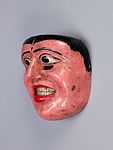Mask
About this object
History of use
The Kolam is a secular entertainment with considerable elements of social satire. It incorporates narrative, mime, dance, and music. A Kolam performance usually has four episodes, the precise content of which may vary. These consist of a prelude, detailing the origin of the drama, the arrival of a royal party and dances by characters mythical, human and animal, the enactment of a popular story or stories, and a purifying demon dance. This mask represents a mythical figure, Gama Gani, a middle-aged village woman.
Narrative
Collected from the attic of the Hikhaduwa Shop, Sri Lanka. Made 10-15 years before collection (collector's notes). Yak(k)as = demons; Gama Gani = village wife.
Cultural context
exorcism
Iconographic meaning
The colour combinations of the face differentiate human characteristics from super-human. The villagers are less important characters, represented with uncouth gaping mouths that display an exaggerated set of teeth.
Physical description
Mask depicting the rounded and lined face of a middle-aged village woman (kolam mask). The mask has a low forehead terminating just above the hairline and extending in shelf-like projection (unpainted with rough surface) towards the inner side of the mask. The face is pink, the hair, eyebrows, pupils, and rims of the eyes are painted black, the protruding lips are red, and the teeth and remainder of the eyes are painted off-white. Black dot directly below hair part. Directly below each eye is a hole. The nose is a sharp, narrow, triangular shape with flared nostrils.
Categories
Materials
